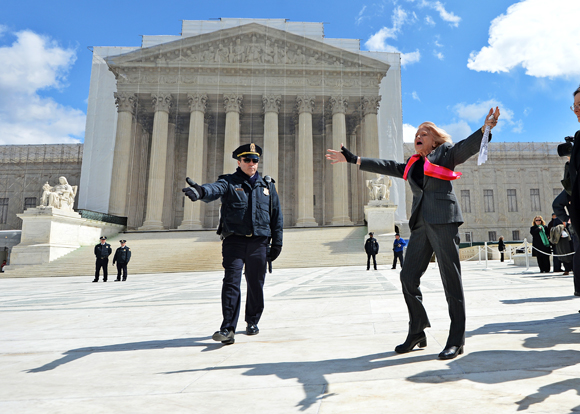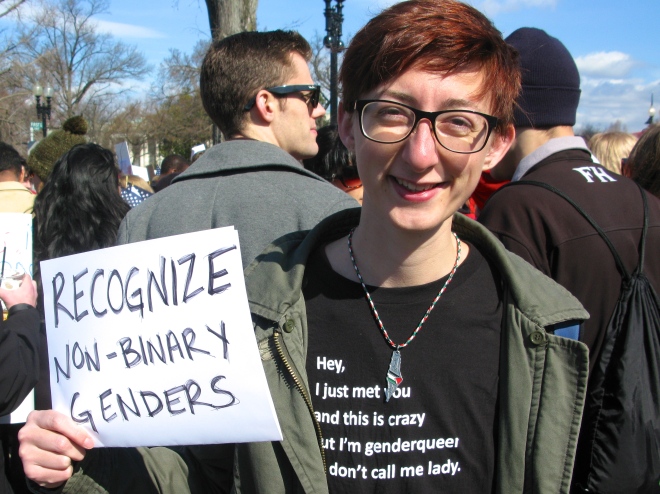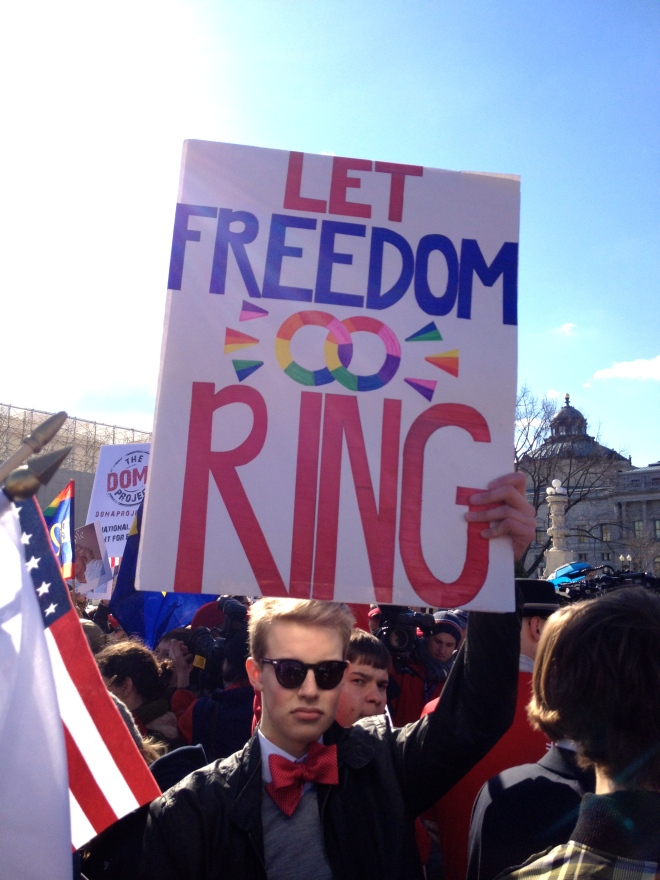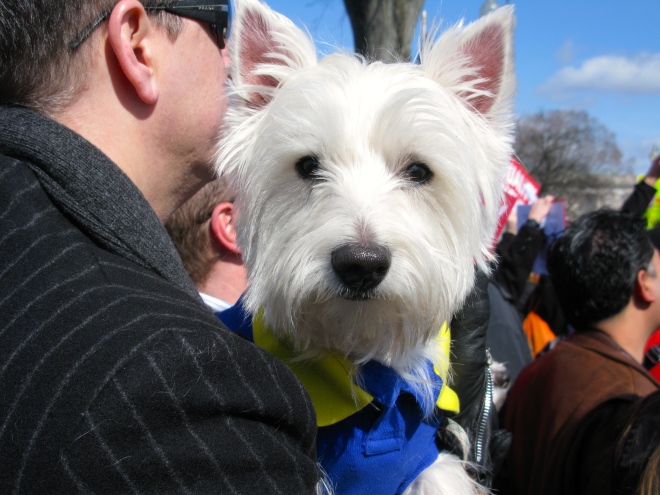I caught a glimpse of Edith Windsor, the plaintiff in United States v. Windsor, on the steps of the Supreme Court on Wednesday, moments after oral arguments in her challenge to the odious Defense of Marriage Act were concluded. I even managed to get a picture of the spunky 83-year-old, but it is awful. She is gingerly making her way down the courthouse stairs, supported on each side by a younger woman. She is looking down, and her face is almost entirely covered by her impossibly thick mane of blondish hair. You can see the hot pink scarf she wore for her day in court as well as the diamond brooch that her late wife, Thea Spyer, gave her in lieu of an engagement ring in 1967 (because the two knew that a ring would engender curiosity among Windsor’s co-workers at IBM). Still, my picture, hastily shot from the crowd waiting eagerly on the sidewalk in front of the court, has no focal point and doesn’t capture at all the energy and grace with which Windsor is playing the historic role in which she finds herself.
Fortunately, another, much more skilled, photographer managed to capture everything my own pathetic snapshot missed on Wednesday afternoon:

Edith Windsor in front of the Supreme Court. 3/27/13. Photo Credit: JEWEL SAMAD/AFP/Getty Images. Via.
I am so taken by this image, which brilliantly captures the moment mostly by what it leaves out. To the right of the picture you see the edges of the press area, which was a tangled mess of people and equipment. The photographer is positioned in front of the crowd in which I was standing and to which Windsor is so exuberantly gesturing, so you see none of that motley, mostly happy crew of sign holders and smart phone documentarians. (The only unhappy people I encountered in the crowd were a couple of anti-circumcision protestors who wore white pants with strategically placed bright red paint spots. Can’t say I disagree with you, kids, but, well, there’s a time and place for everything, right?) Instead of the dozen or so cops who were stationed across the steps, you get just one debonair beefcake who seems more chorus boy than law enforcement officer. Don’t you love the way he seems to present the gorgeous, aging diva for her curtain call? The cop is also perfectly positioned to obscure the main entrance to the court, which at the moment is an unsightly opening in the canvas covering the west facade of the building. (What you see there is actually a full-size photograph of the facade, which is being restored. We apparently picked this clever trick up from Europe. Who knew?) The effect of the cop’s positioning is both to reduce clutter and to heighten the monumental superficiality (or superficial monumentality?) of the scrim enclosure. How fabulous is it that the Supreme Court of the United States is deliberating the legal status of gender in marriage behind a massive curtain/screen/photograph, a giant artifice of the edifice in which the nation’s laws are adjudicated? It is as though, in this moment of acute gender trouble, Judith Butler has been named the Architect of the Capitol. No wonder Justice Scalia is so on edge!
Also: I like the puffy white clouds and the pretty azure sky in the top third of the photo and the way Windsor’s head and left hand break up into that space. I defer to my friend Kate Flint‘s judgments on this point, but it seems to me the photograph beautifully exploits the rule of thirds to make Windsor the center of energy and attention. With her mouth and arms wide open, she looks as if she could huff and puff and blow down the monumental yet insubstantial building behind her. It is a glorious image of diva citizenship, of a New York queen who has made her pilgrimage to Washington determined to remake the intimate public sphere. Which is, of course, exactly what Edie Windsor is doing these days.
I got a few decent photos of the scene on the sidewalk in front of the court on Wednesday. I was pleased to see that there were signs of ideological diversity in the pro-marriage crowd, aside from the aforementioned opponents of circumcision. I liked seeing this smiling critic of the gender binary:
And these devoted, warm-blooded spouses from two countries (this one’s for you, Robert McRuer):
Yes, homonormativity was well and attractively represented:
And there were actually not one but two really cute Westies in matching Ralph Lauren dog sweaters with two equally adorable guys, but this was my favorite of the several photos I snapped of the happiest queer pack in Washington:
There have already been mountains of commentary, analysis, and speculation produced on the biggest, gayest week in American legal history. You don’t need more of that from me, but if you are looking for the good stuff I recommend that you check out the indispensable SCOTUSblog, which has been all over both the Windsor case as well as Hollingsworth v. Perry, the case on the constitutionality of California’s Proposition 8, which struck down the right to same-sex marriage in the state in 2008. For queer legal analysis of both cases, check out Nan Hunter‘s Hunter of Justice blog, especially these posts: on what might happen next; on what happened in the DOMA argument; on what happened in the Prop 8 argument. Suzanne Goldberg has also done a couple of eloquent reflections on what it felt like to be a longtime LGBT legal advocate sitting in the Supreme Court during oral arguments on two such high-stakes cases. Those are posted here and here on Columbia’s Gender and Sexuality Law blog.
Queer critics of marriage have not been silent during this moment of (impending, apparent) homonormative triumph. Laura Flanders, in The Nation admits to getting teary while witnessing the same-sex wedding of a couple of close friends in Manhattan, despite her deep queer and feminist resistance to the institution. She tries to imagine that the profound pledge to love and cherish that is the core of the marriage vow might be extended outward to include all members of society, not just those to whom we are intimately tied. Lisa Duggan has been raining on the marriage parade all week on Facebook, reminding readers of HRC’s dubious history and the otherwise horrible politics of many of the corporations that have now signed on to the cause of marriage equality. She provided a link to a prescient piece she published last fall in The Scholar and the Feminist Online in which she forcefully, stirringly outlines a “beyond marriage” agenda that would “expand the forms of partnership and household recognition begun by the LGBT movement in the 1970s” rather than contract them, as the marriage movement has done.
I respect the critique and share the skepticism. I cling, proudly and stubbornly, to my own position as a queer against marriage for marriage equality, a stance outlined here and here, among other places. And yet Wednesday afternoon, I, too, found myself fighting tears as I stood in the sunshine of a spring that has been reluctant to come to the national capital area this year. Wednesday was my birthday, and I realized on Tuesday that I wanted to spend part of it demonstrating the solidarity I feel with Edith Windsor, standing on the edge of changes I could never have imagined thirty or so springs ago when I kissed a girl and felt the course of my life shift forever. Of all that I have read and heard about these cases, what has resonated for me most is perhaps a short post by Amy Davidson in her Close Read blog at The New Yorker. It’s titled “Will the Supreme Court Recognize Edith Windsor?” It really comes down to that, doesn’t it? Will the nine justices of the court — or at least five of them — recognize Edith Windsor as a person deserving of the same rights to which other persons similarly situated are entitled? Will they see her, as Jewel Samad clearly saw her, in the photo at the top of this post, as someone worthy of recognition not because she is well off and elegantly dressed but because she is alive and human and a citizen of this country?
That is all, my darlings, and, as I suspect you know, that is everything.






My friend Sean was spot on when he said that Windsor is the spitting image of Angie Dickinson.
LikeLike
OMG, true! Soon to be a major motion picture, I bet. Wait, Angie is still alive, right?
LikeLike
Windsor is only a year older than Dickinson, who is still alive.
LikeLike
It’s insanely cute how that little doggie’s fur swirls around its face!
LikeLike
I suspect that cute little doggie’s daddies devote oodles of time and/or money to creating that look. Such beauty ain’t cheap or easy, Physio.
LikeLike
Srsly?
LikeLike
On the one hand, no American citizen should have to pursue a case all the way to the Supreme Court to have her basic rights affirmed. On the other hand, sometimes the right plaintiff to carry out the task of getting the rights of a whole class of people affirmed shows up at the right time. In the case of Loving vs. Virginia, the Loving’s name was so perfect (and their situation and bravery in being willing to stand in the limelight compelling). In Edith Windsor’s case, the situation is equally compelling, and she has just the temperament and bearing to carry off the part (though another wonderful part of the demonstrations in front of the building, from what I’ve read, is the tremendous diversity of same-sex couples, single GLBT people, and straight allies participating. Part of all the struggle is getting to the point where being G, L, B and/or T can be just one part of one’s identity, not the defining one, and we seem to be making progress in that direction). As the person who inherited several circle pins that my father gave to my late mother during their courtship, I also find that detail particularly moving (but mom, of course, eventually received, and was able to wear, a diamond engagement ring and, a bit later, a wedding ring, with no awkward questions involved).
And I hadn’t realized we were seeing a scrim rather than the actual front of the building. How perfect.
And happy birthday, a bit late!
LikeLike
I’m so glad you were there to see Edith Windsor. The photos of her made me cry (I guess I’m a maudlin old lady) — for her hope, for her love for her wife, for her loss, and for the arguments on her behalf. I’m at a conference right now, and another widow said to me last night, “Widows get it about their experience in a way others don’t.” But I have no idea of Windsor’s experience of widowhood, and the denial of her marriage. But I think the bottom line is it just seems wrong: I loved Ginsburg’s comment about the “skim milk” marriage. (And don’t you think it’s obvious that a woman would come up with that image?)
LikeLike
I, too, loved Ginsburg’s metaphor, but wondered how well it would translate for a younger generation raised to view full-fat milk as suspiciously fatty/dangerous (rather than as the real real thing).
LikeLike
Reblogged this on Pop! Culture & Politics.
LikeLike
I love to see the humor in the signs. It’s always so humanizing after all this dehumanization.
Some of the statements by the conservative judges were jaw-dropping. What world do they live in?
LikeLike